Plant Profiles
Click on the first letter of the common name of the plant you wish more information about.
A | B | C | D | E | F | G | H | I | J | K | L | M | N | O | P | Q | R | S | T | U | V | W | X | Y | Z
B
- Bacopa
- Bat Flower
- Beach Sunflower
- Bengal Clock Vine
- Blanket Flower
- Blood Lily
- Butterfly Bush
- Blue-eyed Grass
- Bolivian Sunset
- Bougainvillea
- Butterfly Ginger
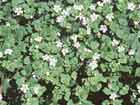
Bacopa
Scientific Name: Sutera cordata
Growth Habit: An evergreen-vining perennial often used as an annual; grows to 5 inches tall and 2 feet wide.
Light: Plant in full sun to lightly shaded locations.
Feedings: Feed container plantings every other week with a 20-20-20 or similar fertilizer; apply a general garden fertilizer to in-ground plantings monthly.
Water Needs: Prefers a moist soil; grows best with weekly waterings.
Ease of Culture: Easy.
Propagation: Start plants from cuttings.
Hardiness: Tender; needs cooler weather for best growth but should be protected from freezing temperatures.
Major Problems: Stay alert to whitefly infestations and control with an oil spray as needed. Also plant in a well-drained soil to avoid root-rot problems.
Pruning: Periodically trim the ends of new shoots to encourage branching and plants with a dense growth habit.
Uses: A new plant for the fall through spring garden. Bacopa can be grown as a ground cover but finds much more use as a cascading addition to hanging baskets and other container plantings. Gardeners like to include bacopa as a border in container gardens to contrast with other colorful cool- season flowers. Plants flower continuously, opening small but plentiful blossoms. A white flowering selection is most commonly marketed, but pink, lavender and blues should be available shortly.
Florida Native: No; native to South Africa.
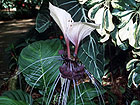
Bat Flower
Scientific Name: Tacca integrifolia
Growth Habit: A clump-forming evergreen perennial with broad green leaves arising from a rhizome and growing to 2 feet tall and wide. The leaves are dark green and have a crinkled appearance, growing to 2 feet long and 10 inches wide.
Light: Plant in shade to filtered-sun locations.
Feedings: Apply a 20-20-20 or similar fertilizer monthly March through November to container-grown plants. Apply a light scattering of a general garden fertilizer every other month during the same time period to in-ground plantings.
Water Needs: Prefers a moist soil; water when the surface soil begins to dry during the warmer months. Allow the surface soil to dry during the cooler months. Keep in a naturally humid location.
Ease of Culture: Medium; needs more care than most plants.
Propagation: Start plants by dividing older clumps during late spring and summer. Seeds are available but difficult to germinate.
Hardiness: Tender; best grown in containers that can be protected from cold.
Major Problems: Must be protected from cold, which makes plants more susceptible to rot and general decline. Failure to keep in a humid location causes brown leaves to form. Leaves may be damaged by slugs.
Pruning: Trim old leaves and flowers back to the base of the plant as needed.
Uses: The bat flower is a conversation starter and should be displayed on a porch, patio or along walkways where visitors are sure to notice the unusual inflorescence developing May through November. Also called the devil flower or cat's whiskers plant, the trick to success is finding the right location with shade and humidity. Avoid breezy spots and be ready to give the plant a warm area with temperatures consistently above 50 degrees during the cooler months. The plants can be grown in the ground but are best kept in containers locally.
Florida Native: No; native to Southeast Asia.

Beach Sunflower
Scientific Name: Helianthus debilis
Growth Habit: A long-lived annual vine that grows to 24 inches tall and 48 inches wide, filling with glossy triangular leaves. Plantings give an almost continual display of 2-inch-diameter yellow flowers with dark centers.
Light: Plant in full-sun locations.
Feedings: None needed; plantings receive needed nutrients from decomposing leaves and rainwater.
Water Needs: Keep moist until roots grow into the surrounding soil. Thereafter, plantings survive with moisture from seasonal rains.
Ease of Culture: Easy.
Propagation: Start new plants from seed and cuttings.
Hardiness: Hardy; damaged by severe freezes but grows back from stems near the ground or from seeds.
Major Problems: Avoid poorly drained areas or overwatering which encourages root rot. Plantings are considered pest free.
Pruning: Keep plants in bounds by pruning vigorous shoots as needed. Pruning also may be needed in garden settings to remove plants completing their life cycles.
Uses: Beach sunflower plantings are ideal for coastal gardens because they tolerate salty growing sites. They also can be used as a ground cover in the sandy soils throughout Florida. In time, the plantings decline but grow back from seeds that fall to the ground. Plantings are in bloom year-round except in the colder locations. The flowers attract nectar-feeding butterflies, and the seeds are a favorite food of wildlife.
Florida Native: Yes.
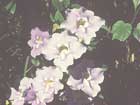
Bengal Clock Vine
Scientific Name: Thunbergia grandiflora
Growth Habit: An evergreen vine with shoots growing more than 20 feet long. The leaves are dark green and oblong and grow to 8 inches long and half as wide.
Light: Plant in full sun for best flowering.
Feedings: Apply a general garden fertilizer once monthly in March and June if needed to encourage growth.
Water Needs: Tolerates short periods of drought. Grows best if watered every 10 to 14 days.
Ease of Culture: Easy.
Propagation: Start plants from seed, cuttings or air layers.
Hardiness: Medium; may be damaged by freezes but usually grows back from buds near the ground.
Major Problems: Leaves occasionally are damaged by chewing insects, but controls seldom are needed. The vine also may exhibit minor nutrient deficiencies that can be avoided by including these nutrients in the fertilizer.
Pruning: This vigorous grower during the warmer months may need trimming to remain in bounds. Also requires pruning during mid- to late February to remove cold-damaged shoots and to control growth.
Uses: Everyone likes the sky blue to white blooms of the Bengal clock vine opening to 3 inches in diameter, but not every landscape has the space to grow this plant. Train to a long fence or extended trellis to enjoy the green foliage and clusters of blossoms opening May and October but also sporadically anytime it's warm. Plantings also may be trained to disguise a wall or cover an arbor.
Florida Native: No; native to India.
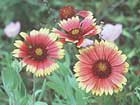
Blanket Flower
Scientific Name: Gaillardia pulchella
Growth Habit: A long-lived annual with an upright to sprawling habit growing to 18 inches tall and wide. The leaves are lancelike and smooth-edged on upper plant portions and toothed near the base; they grow to 4 inches long and 1 inch wide.
Light: Plant in full-sun locations.
Feedings: Fertilizer is seldom needed except to encourage growth. Where needed, feed lightly with a general garden product in March, June and September.
Water Needs: Keep moist until established. Thereafter, plantings usually survive with moisture from seasonal rains.
Ease of Culture: Easy.
Propagation: Start plants from seed or cuttings.
Hardiness: Hardy.
Major Problems: Plantings need a well-drained soil to prevent root-rot problems. Caterpillars may chew holes in the leaves but seldom need control. Garden flea hoppers cause pinpoint-size yellow spots in the leaves, and they may be a bit unsightly but they usually can be tolerated.
Pruning: Some trimming may be needed to keep sprawling plants off pathways. Also remove old flower heads throughout the year to encourage additional blooms. Clean plantings of older stems and brown leaf portions during late winter as new growth begins.
Uses: Add to flower beds, planters and perennial gardens for periods of extended color. Plants open daisylike yellow and red flowers year-round that last for more than a week. Gaillardia is often included in wildflower plantings where it self-seeds to continue the displays. Plantings are salt-tolerant and can be used near beaches. Blossoms attract butterflies and are often cut for bouquets.
Florida Native: Yes.
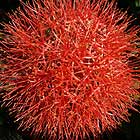
Blood Lily
Scientific Name: Scadoxus multiflorus
Growth Habit: An upright perennial bulb with a single stalk of foliage growing to 18 inches tall and wide. The leaves are lancelike in shape and produced in whorls growing to12 inches long and 6 inches wide.
Light: Plant in shade to filtered sun.
Feedings: Apply a light scattering of a general garden fertilizer once monthly in June and August.
Water Needs: Plantings prefer a moist soil during periods of growth late spring through early fall; water at least weekly. Allow the planting sites to dry and receive seasonal rains late fall through midspring.
Ease of Culture: Easy.
Propagation: Start plants by division of older clumps during late fall and winter.
Hardiness: Hardy.
Major Problems: Slugs often consume major sections of leaves. Control with a shallow saucer of beer that acts as a trap, or use natural baits available from garden centers. Grasshoppers also may feed on the leaves but seldom need control.
Pruning: Remove flower heads as the blossoms fade by midsummer. Trim declining leaves as plants go dormant during October.
Uses: An attractive plant for the shady gardens, often opening an inflorescence more than 6 inches in diameter and composed of many small red blossoms in June and July before the foliage appears. Plant clusters of several bulbs set 8 to 10 inches apart for a burst of color. The foliage that follows flowering is bright green and serves as a ground cover until early fall when the plants decline. Blood lilies also can be grown in containers to add to the porch or patio for seasonal flowers and foliage.
Florida Native: No; native to South Africa.
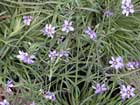
Blue-eyed Grass
Scientific Name: Sisyrinchium atlanticum
Growth Habit: A clump-forming perennial with grasslike leaves creating plants that grow more than 12 inches tall and wide. The leaves are linear, bright green and grow to 12 inches long and 1/4-inch wide.
Light: Plant in full-sun to lightly shaded locations.
Feedings: Feed lightly with a general garden fertilizer once in March.
Water Needs: Needs a moist location. Plant in naturally damp soils, or water at least weekly.
Ease of Culture: Easy.
Propagation: Start plants from seed or by division of older clumps.
Hardiness: Hardy.
Major Problems: Few problems, but plants likely will decline in a location that is too dry.
Pruning: Trim old flower heads after spring bloom and remove declining leaves as needed.
Uses: An attractive plant that resembles a grass but is really a member of the iris family. The flowers, which bloom February through May, are up to 1/2-inch in diameter and are mainly blue in color with a yellow center; a white-flowered selection is also available. Plant as a ground cover or use as an accent in perennial flower beds and along walkways. This is an ideal plant to add to bog gardens and to use in naturalized plant settings. It also may be grown in containers to set on patios and balconies.
Florida Native: Yes.
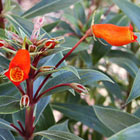
Bolivian Sunset
Scientific Name: Gloxinia sylvatica
Growth Habit: An upright multistemmed evergreen perennial growing to 2 feet tall and wide. The leaves are dark green and lancelike, growing to 6 inches long and an inch wide.
Light: Plant in locations with morning sun and afternoon shade or a full day of filtered sun.
Feedings: Apply a general garden fertilizer once a month March through November to in-ground plantings and every other week during the warm months to container plantings; none during the winter.
Water Needs: Keep in-ground plantings moist with weekly waterings when plants are growing; water less during the winter months. Check container plantings daily for water needs, and moisten when the surface soil begins to dry.
Ease of Culture: Easy.
Propagation: Start plants from cuttings or by dividing older clumps.
Hardiness: Tender; damaged by frosts and freezing weather but usually grows back from buds near the ground.
Major Problems: Mealybugs may encase the tips of new shoots to cause yellowing and decline. Control with a soap spray as needed. Leaf-spot-fungal organisms can affect plants during the rainy season. Keep in an airy location and treat with a fungicide for leaf spots as needed.
Pruning: Trim back the tips of growing shoots to cause branching as needed to maintain a compact growth habit. Also, remove faded flowers to maintain an attractive plant. Remove cold-damaged portions and trim to reshape the plants in March.
Uses: Plants can be added to shaded flower beds to enjoy the dark foliage and brilliant tubular-shaped orange-red blooms with yellow centers October through January. Many gardeners also like to grow the plants in containers that can be added to patio or balcony plant collections and moved to a warm location during the cold weather.
Florida Native: No; native to Bolivia and Peru.

Bougainvillea
Scientific Name: Bougainvillea species
Growth Habit: An evergreen sprawling shrub to vining plant growing to 15 feet tall and twice as wide. Leaves are oval to heart-shaped and grow to 4 inches long and wide.
Light: Tolerates light shade; grows and flowers best in full sun.
Feedings: Feed lightly with a general garden fertilizer once each month in March, June and August.
Water Needs: Drought tolerant; needs frequent watering until established. Thereafter, plantings usually survive and flower best with moisture from seasonal rainfall.
Ease of Culture: Easy.
Propagation: Start plants from cuttings.
Hardiness: Tender; damaged by freezes but usually grows back from main stems or buds near the ground.
Major Problems: Gardeners frequently have trouble getting plants to rebloom after planting. A lack of flowering is usually because of overwatering and overfeeding that promotes growth rather than blooms. Caterpillars also damage the leaves and are best controlled with a natural insecticide when noted.
Pruning: Avoid major pruning to encourage blooms. Perform needed trimming between May and mid-August to ensure winter flowering.
Uses: A strong accent plant often grown as a wall covering or vine for a trellis. Bougainvillea are also planted in hanging baskets and large containers to ramble up and over the edges. The small tubular flowers are white and surrounded by the more obvious colorful bracts of red, pink, orange, purple or white. Major flowering occurs November through April, but plants may produce sporadic blooms at any time of the year.
Florida Native: No; native to Brazil.
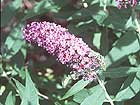
Butterfly Bush
Scientific Name: Buddleia davidii
Growth Habit: A rounded evergreen shrub with multiple arching branches growing to 8 feet tall and 6 feet wide. The leaves are deep green and lance-shaped, growing to 8 inches long and 2 inches wide.
Light: Plant in a full-sun location.
Feedings: Apply a general garden fertilizer once monthly in March, June and September.
Water NNeeds: Tolerates short periods of drought; grows best when watered every 10 to 14 days.
Ease of Culture: Medium.
Propagation: Start plants from cuttings.
Hardiness: Hardy; may be damaged by freezing temperatures but grows back from buds near the ground.
Major Problems: Wet-soil conditions may cause stems and roots to rot. Plant in a well-drained soil. Roots also may be damaged by nematodes, and caterpillars often feed on the foliage.
Pruning: Control vigorous warm-season growth that overhangs walkways and affects nearby plantings. Also trim faded blooms to encourage extended flowering. Remove cold-damaged portions and trim older stems back to within a few feet of the ground during February to encourage vigorous shoots with blooms for spring.
Uses: An attractive accent plant opening arching clusters of white, pink, red or purple flowers May through November. As the name suggests, this is a favorite plant of butterflies. Add butterfly bushes to foundation plantings, use as a backdrop for perennial gardens, plant near a patio or display along walkways.
Florida Native: No; native to China.
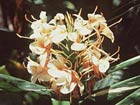
Butterfly Ginger
Scientific Name: Hedychium species
Growth Habit: Upright semievergreen perennials, with long stalks of clasping leaves, growing to 6 feet tall. The leaves grow to 2 feet long and 5 inches wide.
Light: Plant in full-sun to lightly shaded locations.
Feedings: Apply a general garden fertilizer in March, June and September.
Water Needs: Prefers a moist soil; maintain a mulch layer and water weekly during periods of drought.
Ease of Culture: Easy.
Propagation: Start plantings by dividing older clumps.
Hardiness: Tender; damaged by frosts and freezing weather but grows back from underground rhizomes.
Major Problems: Chewing insects may cause minor damage to the foliage but seldom need control.
Pruning: Plantings grow vigorously during the warm, humid months and often need trimming to remain in bounds. Many die back during the winter or have cold damage that should be removed during late February.
Uses: Butterfly gingers add the tropical look to Florida landscapes. Cluster several plants to form a backdrop for gardens or a view barrier along walkways and boundary lines. Plantings are also ideal additions to perennial gardens and useful as accent features near water and bog plantings. All produce attractive and often fragrant white, red, pink, orange or yellow flower clusters May though October. They can also be added to container gardens for porches and patios.
Florida Native: No; native to India and Malaysia.

